FZ:OZ - FZ PLAYS FZ - JOE'S SERIES - ZAPPA '75 - PHILLY '76: THE FIVE- AND SIX-PIECE BAND
From the fall tour of 1975 through the winter tour of 1977 Zappa played most of the time with a five piece band. Five was the minimum number of musicians that he deemed necessary for playing his music. Only six pieces with the band in this form have been released by Zappa himself, being four solos and two songs. The majority of live music from this period stems from the concerts Zappa gave at Christmas time, 1976, when he played with an augmented band. So at least in a historical sense you can say that the live recordings showed a gap. The ZFT has more than compensated for this by releasing five live albums themselves, namely "FZ:OZ", "Frank Zappa plays the music of Frank Zappa", "Joe's menage", "Zappa '75 Zagreb/Ljubljana", and "Philly '76". The first four cover the months from November 1975 through February 1976. During the summer of 1976 the composition of the band changed, but it remained a five piece band. Till the release of "Philly '76" only the "Conceptual continuity" bootleg from the "Beat the boots" series covered the band in this specific line up. On three occasions Zappa tried to include a female member as a follower up for Ruth Underwood. Norma Jean Bell played sax during some of the 1975 gigs (to be heard on "Joe's menage" and "Zappa '75 Zagreb/Ljubljana"). Bianca Odin played keyboards for a month and a half during the fall tour of 1976.
JOE'S CAMOUFLAGE
Viola player Novi Novag can be heard on "Joe's camouflage". This ZFT release contains rehearsal recordings from 1975 with the band still being a 7-member group. Publicity photos were made till Zappa decided it didn't work out good enough and continued with a smaller band. Below an outtake from the CD leaflet with Novi Novag, Terry Bozzio and Denny Walley. "Joe's camouflage" thus contains unique material of a band that never came to be. As a rehearsal recording all tracks would need further editing and development (and some are of poor sound quality). Still the version differences between these very early recordings and the later album releases are of interest. But what makes it really worthwhile is the inclusion of two unreleased tracks, that with some further editing, could belong to Zappa's better work.
Phyniox
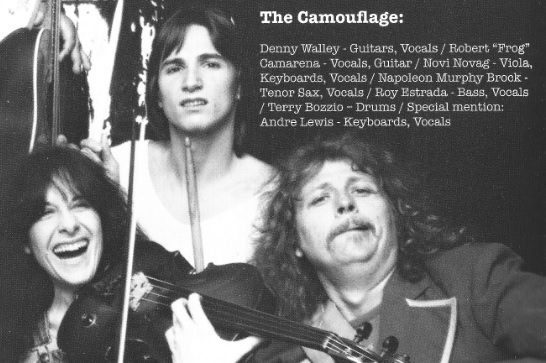 "Phyniox" is a beautiful example of a subtle alternation between closely related scales, in this case Ab major and Ab Mixolydian. The example
below starts with just the chords from the first block in Ab major. At this point the synthesizer F in the bass indicates F minor, but this
F soon gets overruled by the Ab by the bass guitar. The rhythm figure from bar 1, staffs 2-3, is maintained all through. Bars 3-4 contain
the bass/guitar vamp from the song. It's using an Ab-Bb-Db-Bb progression, four notes that are part of both the Ab major and Ab Mixolydian scale. The
alternation between these two scales is effected by the accompanying chords. The main chords for the major sections are Eb, Fm and Fm7. For the Mixolydian sections
it's the Ebm chord. Thus including a switch between G natural and G flat. The scheme is 8 bars in major alternating with 8 bars in Mixolydian (or four times the vamp).
"Phyniox" is a beautiful example of a subtle alternation between closely related scales, in this case Ab major and Ab Mixolydian. The example
below starts with just the chords from the first block in Ab major. At this point the synthesizer F in the bass indicates F minor, but this
F soon gets overruled by the Ab by the bass guitar. The rhythm figure from bar 1, staffs 2-3, is maintained all through. Bars 3-4 contain
the bass/guitar vamp from the song. It's using an Ab-Bb-Db-Bb progression, four notes that are part of both the Ab major and Ab Mixolydian scale. The
alternation between these two scales is effected by the accompanying chords. The main chords for the major sections are Eb, Fm and Fm7. For the Mixolydian sections
it's the Ebm chord. Thus including a switch between G natural and G flat. The scheme is 8 bars in major alternating with 8 bars in Mixolydian (or four times the vamp).
Phyniox (take 1), 0:07-0:45 (midi file).
Phyniox (take 1), 0:56-1:23 (midi file).
Phyniox (take 1), 0:07-0:45 (transcription).
Phyniox (take 1), 0:56-1:23 (transcription).
The first example contains the switch from Ab major to Ab Mixolydian in bar 7. The second example includes the last bar from this first Ab Mixolydian block,
after which the song returns to Ab major. Yet again this is an example of Zappa mingling two closely related scales, because for his own soloing he follows
Ab Lydian during bars 2-5, before he continues in Ab major himself as well. The difference between these two scales, D natural versus D flat, causes dissonances
at the beginning of bar 5. This mingling of closely related scales is a common feature in Zappa's music, thus normal that it not only happens in written compositions
(like "Echidna's arf (of you)"), but also when Zappa and band members are improvising. So you can have an F major block in a largely F Lydian composition as
in the "Sinister footwear III" example in this study. The second "Dickie's such an asshole" example shows band members mingling scales. "Phyniox" can thus
also be seen as a refined example of the status scales have in Zappa's music, in this case the three major type scales: these three are used as
more or less equal with a preference for Mixolydian. The overview in the
Burnt weeny sandwich section illustrates this en masse.
Phyniox (take 2), section from the coda (midi file).
Phyniox (take 2), section from the coda (transcription).
Other than "Phyniox, take 1", "Phyniox, take 2" contains a coda with the band changing the vamp to a C-Ab-Gb-Eb progression.
The chords still continue as before. Thus the scale becomes C Phrygian/Locrian at the
end. Specifically the chords from the previous major part, now create dissonances with the closing vamp (F and G versus Gb).
Phrygian is a relatively uncommon scale that Zappa uses every once in a while.
Reeny ra
Next are two examples from "Reeny ra". The set-up of this song goes as:
- 0:00 Theme I, played instrumentally (first example below). It's a little theme of one bar, played three times, followed by a closing bar. The meter is 12/16. The key is G
Mixolydian. The accompanying chord progression, that you can hear in the background, is I-IV-I-IV-VII-IV-I. The bass ultimately leads to a lower D, as if Zappa
would like to end in D Dorian.
- 0:10 Theme I, played twice with vocals. It has no real lyrics. Possibly Zappa was still working on it.
- 0:29 Theme II, mainly a vocal section.
- 0:43 Theme III, an instrumental riff played four times.
- 1:03 Repetitions of theme I as above.
- 1:33 Guitar solo over a vamp. This vamp switches the pedal note from G to B, thus moving over to Locrian, an unusual type of scale that also is rare in Zappa's output.
Here it's B Locrian. The only other examples in Locrian in this study are two bars from "Peaches III", a phrase from "Waka/Jawaka" and a progression from "Jumbo go away", that one could
interpret as G Locrian. The second example below contains a couple of bars from this section. The bass vamp follows B-C-D-C. The guitar part begins with the G7 chord,
followed by a melody that involves altered notes. Every two bars you have a chord progression for the brass: Gm-F-Gm-G (by itself thus more a G minor towards
G major movement).
Reeny ra, theme I, 0:01-0:10 (midi file).
Reeny ra, solo fragment, 1:53-2:04 (midi file).
Reeny ra, sections (transcription).
- 3:45 Repetitions of theme I.
- 4:02 Coda.
- 4:12 End.
Any downers? (1975)
Compared to the later version on "You are what you is", "Any downers?" on "Joe's camouflage can be called the crude version of this song.
It's entirely based upon a I-VII progression by the bass in F# minor (Aeolian), over which a VI-VII chord alternation can be heard. The bass
notes are part of these chords, but in this study I always let such bass notes determine the key note. In general tonics in Zappa's music get
determined by bass pedal notes, rather than by harmonic cadences, and one should better follow one approach only.
Any downers?, outro (midi file).
Any downers?, outro (transcription).
This 1975 version of "Any downers?" lasts six minutes, much longer than the two minutes on "You are what you is". This can be done because the
I-VII progression is not only applied to the two themes of this song, but is also used similar to a vamp. A little dialogue can be heard starting with one person asking
"are you holding any downers?" and the other replying with "no, I don't have anymore". On "You are what you is" the second theme (with "no, I don't have anymore")
has been given a chord progression of its own. Zappa plays little guitar solos during the 1975 version, one halfway and the other as an outro.
The example above contains most of this outro. It begins with ticking the F# as 16th notes, followed by the E-chord. During bars 1-2 the keyboard
players are still playing the VI-VII alternation in a straightforward manner, but this is getting quite loose for the remainder of this example.
In bar 6 of the example the actual soloing begins, while the bass continues with ticking the F# and E. It ends with the keyboard playing the F#m chord, as if the song was to end normally
with a chord upon the tonic, but shortly moves over to the D chord again.
See the You are what you is section at "Any downers (1981)" for more about this song.
FZ:OZ
"FZ:OZ" is the third release compiled by the Zappa Family trust from the tape archive.
It's the first done under the Vaulternative Records label and more has appeared since. It contains an about full length concert from 20 January 1976, recorded at
the Hordern Pavilion in Sydney, Australia. It's from the period that, apart from Napoleon Murphy Brock,
the members of the Roxy and Elsewhere band had left and Zappa was touring with a smaller
five member band in different set ups. Because of this most of the virtuoso pieces were left out and Zappa had to play
a lot of guitar himself. It changes the character
of the concert a bit to a more pop-like form. Zappa was in good shape soloing that
night. The difficult pieces could return at the end of 1976 when Zappa assembled
a large band that played on the "Zappa in New York" CD.
There's a direct relation between this album and the "Zoot allures" studio album from 1976. About all
the songs of the latter album were played live as well and the
"Black napkins" en "Zoot allures" solos from this album were developed on the road. This also applies to the
"Ship ahoy" solo from "Shut up 'n' play yer guitar", that here appears in a version that is
included in the
"Zoot allures" track. Also for the "Zoot allures" album Zappa used little personnel and
chose to play much guitar, solos as well as the chords.
Kaiser rolls
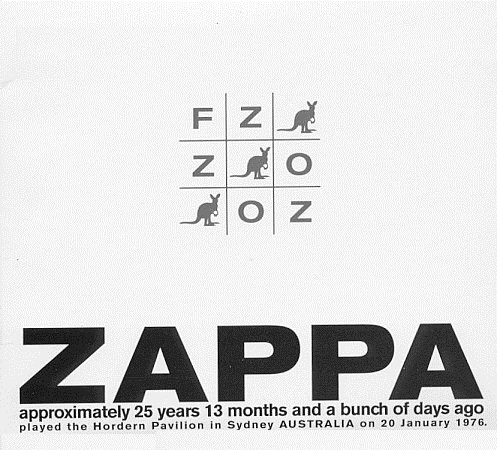 The double CD (cover to the right) includes one unreleased song that's completely new, named "Kaiser rolls",
that I'm presenting here by its opening. The instrumental opening bars follow the progression Bm-G-D-Em-(D) twice with
the transition from bar 1 to 2 being syncopic. The repeated bar 5 and bar 13 set the scale to D Mixolydian.
The double CD (cover to the right) includes one unreleased song that's completely new, named "Kaiser rolls",
that I'm presenting here by its opening. The instrumental opening bars follow the progression Bm-G-D-Em-(D) twice with
the transition from bar 1 to 2 being syncopic. The repeated bar 5 and bar 13 set the scale to D Mixolydian.
Kaiser rolls, opening (midi file).
Kaiser rolls, opening (transcription).
Two other tracks are to a degree new. An early version
of "Let's move to Cleveland" gets titled "Canard toujours". The "Hordern intro" is
a combination of the "Naval aviation in art" tape running and concert opening chords.
Personnel on FZ:OZ:
Frank Zappa: guitar, vocals
Terry Bozzio: drums, vocals
Napoleon Murphy Brock: tenor sax, vocals
Roy Estrada: bass, vocals
Andre Lewis: keyboard, vocals
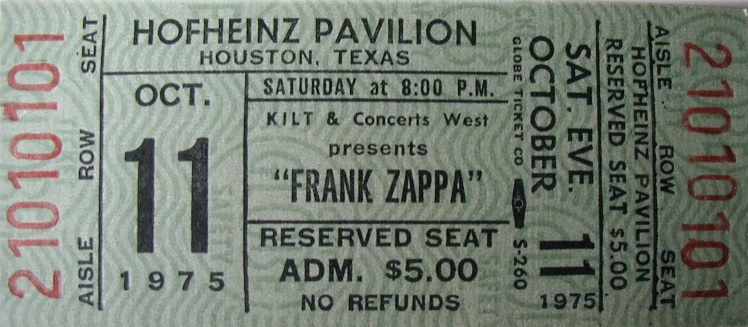
Ticket stub from the 1975-76 tour. Next to the standard American and European legs, this tour also covered Yugoslavia, Australia, New Zealand and Japan.
Keep it greasy (1976)
"Keep it greasy" appeared on the setlist in 1976 and got first released on "Joe's garage" in 1979. The main melody remained
virtually the same, only some seconds with add-ins are different. The bass part and the harmonies from the 1979 variant
have departed a little from the original. The example below is in D Dorian with the meter being 4/4.
Keep it greasy (1976), section (midi file).
Keep it greasy, 1976, section (transcription).
Specific for the 1979 version is the inclusion of a guitar solo, played over a vamp in 19/16.
I'm continuing with this solo from "Keep it greasy (1979)" in the Joe's garage section.
In 1979 the subject of this song, anal sex, made it apt to placing it in the context of anal sex in prisons.
FZ PLAYS FZ
"Frank Zappa plays the music of Frank Zappa", compiled by Dweezil, deals with the three solos, that Zappa considered his signature solos ("Black napkins", "Zoot allures" and "Watermelon in Easter hay"). They are presented in an early state, compared to the final state. All three solos are present in this study. The main theme from "Zoot allures" is being dealt with in the corresponding section. Two versions of "Watermelon in Easter hay" get described in the Joe's garage section.
Black napkins
In the case of "Black napkins" one of the oldest recordings, that could be found, is the one from Ljubljana, Yugoslavia, November 1975. It was a one-time only opportunity
to play in Eastern Europe during the communist era, a permission seldom granted to western pop bands at that time. This early solo shows more
emphatically than the later ones that "Black napkins" was composed as a two-theme song, at some point maybe even a three-theme
song. In this case it wasn't composed on paper, but rehearsed like this by instructing the band. See his introduction to this song
on the ZFT release "Orchestral favorites 40th anniversary".
The transcribed section shows contains the tail of the first theme in bars 1-5. Bars 6-9 are transitional
ones, four bars being the length of the accompanying bass-keyboard vamp. In bars 10-13 the second theme is introduced, repeated relatively literally in bars 14-17 and bars 18-21.
That this is a second pre-arranged theme gets confirmed by the re-entering of the "wee-ooh" accompanying vocals.
On the "Zoot allures" version of "Black napkins" this second theme is also present, though in a different and
much free-er shape. On "FZ plays FZ" Zappa introduces this song as a tender ballad. Indeed the third theme, played
in bars 26-33 of the transcription, is gentle, almost like a lullaby. Again there are four transitional bars between the
successive themes. Maybe this theme was part of the original
composition, maybe it was improvised on the spot.
Black napkins (1975, FZ plays FZ), 1:23 till 2:14 (midi file).
Black napkins (1975, FZ plays FZ), 1:23 till 2:14 (transcription).
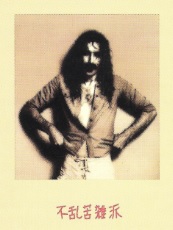 The solo from the "Zoot allures" album, played only two months later, is
of a different nature. This one is far more intense, to the point of being maniac. Apart from the opening themes
the tempo is fast all through. Halfway Zappa is using a sound effect, that Steve Vai identifies as VCF in the
Guitar book (I don't know what it stands for). It makes the sound even more frenetic.
The solo from the "Zoot allures" album, played only two months later, is
of a different nature. This one is far more intense, to the point of being maniac. Apart from the opening themes
the tempo is fast all through. Halfway Zappa is using a sound effect, that Steve Vai identifies as VCF in the
Guitar book (I don't know what it stands for). It makes the sound even more frenetic.
Black napkins (1976, Zoot allures), fragment (midi file).
Black napkins (1976, Zoot allures), fragment (transcription).
Steve Vai succeeds surprisingly
well in getting these bars on paper, using four types of sounds. These are normally picked notes, feedback notes,
scratched notes and unspecified higher frequencies, referred to as spewage. "Black napkins" on "Zoot allures" gets a specific
outro, not present on "FZ plays FZ". The outro begins with jumping overnight into a different key, something Zappa
seldom does (see the Shut up 'n play yer guitar section for the keys used). The solo itself is an alternation of
C# Aeolian/Dorian and D Lydian. See my comment at "Pink napkins" for the mingling of Aeolian and Dorian.
In February Zappa gave four concerts in Japan, the only time a tour would include this country. The 1976 version of
"Black napkins" was recorded live at Osaka, which explains the presence of Japanese signs on the album cover (image to the right).
Purportedly it's his name in Japanese. Two tracks from the Tokyo concert can be found on "YCDTOSA vol. III", while the
"FZ plays FZ" collection contains 15 more minutes from this concert.
For more about "Black napkins" in this study you can look at:
Orchestral favorites section: "Black napkins instructions" with Zappa explaining the chord alternation.
Zoot allures section: the opening bars of "Black napkins" from the FZ Guitar book.
Shut up 'n play yer guitar section: this title played in the shape of "Pink napkins" in 1977.
Lonely person devices
"Lonely person devices" is a recording from february 1976, included in "YCDTOSA Vol. VI". It belongs to a couple of recordings that are included
for their historic interest, despite their lesser demi-bootleg sound quality. Indeed the little story Zappa is telling here about Miss Pinky, and a Finnish
porn magazine a friend had given him, is very entertaining. The year 1975 in the booklet is an obvious writing error.
Lonely person devices, 2:49-3:06 (midi file).
Lonely person devices, 2:49-3:06 (transcription).
Ever since "Black napkins" was written, it remained included in setlists, with many versions appearing on especially the ZFT releases.
"Lonely person devices" is based upon a chord alternation with the first chord being C#m, just like "Black napkins". After having heard
"Black napkins" that often, this creates some sort of an audio-illusion.
At first hearing one is inclined to interpret this as another instance of the band using the "Black napkins" vamp.
When listening more closely you'll hear this isn't the case. The second chord is A instead of D. So it only resembles "Black napkins"
a little, and is actually better described as a I-VI alternation in C# minor. As a I-III alternation in A Lydian is also defendable, since
it's not that clear which chord should be seen as the starting point (the track begins after the concert start of this song). Moreover the rhythm is different. "Lonely person devices"
is in 4/4 with Roy Estrada playing a hemiola every two bars, as shown in the example from above.
JOE'S MENAGE - ZAPPA '75 ZAGREB/LJUBLJANA
"Joe's menage" is taken over from a cassette tape that Zappa gave to one of his fans, Ole Lysgaard. It contains 45 minutes from the concert the Mothers gave at the College of William and Mary, Williamsburg, November 1975. Ole returned it to Gail Zappa, who decided to release it and give Ole a chance to write the liner notes. The sound quality is something you might expect from a cassette recorder with two mikes, better than a bootleg and less than a professional two-track recorder.
Chunga's revenge (1975)
A curious thing on it is Zappa playing a rhythm guitar solo for three minutes during "Chunga's revenge".
It's the only solo on an official CD with him playing in that manner. He would only play rhythm guitar when he
was the only guitar player in the band. Otherwise he preferred to hold his guitar only for playing solos. He had problems with singing and playing
at the same time. Even the weight of a guitar hanging around his neck already hindered him when singing.
Next is a transcription of a section from this solo halfway.
Chunga's revenge (Williamsburg), 9:14 till 9:39 (rhythm guitar solo) (midi file).
Chunga's revenge (Williamsburg), 9:14 till 9:39 (rhythm guitar solo) (transcription).
It begins in D Dorian. In bars 3-6 it's calm with
only one chord varied rhythmically. In bars 7-12 the solo suddenly starts to drift. It's a sequence of 5th and 7th
chords jumping from one scale to another. As a composition it becomes atonal here, specifically if you take into account that
the bass continues with playing D pedal.
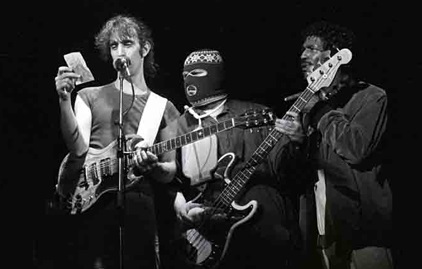
In the middle Roy Estrada in his Illinois enema bandit outfit. "Joe's menage" contains the probably earliest versions of
"Honey, don't you want a man like me" and "The Illinois enema bandit", first released on "Zappa in New York" (1978).
In 2022 the ZFT released "Zappa '75 Zagreb/Ljubljana" including a "Chunga's revenge" performance lasting almost 20 minutes.
It gets spread out over two CDs as part 1 and part 2. It's recorded at Zagreb, November 21st 1975. Fans will recognize
the first example from below as resembling the sequence from "Five-five-FIVE" from the later "Shut up 'n' play yer guitar" album.
On this occasion the meter is 5/8 only, while on "Shut up 'n' play yer guitar" it has become 5/8 + 5/8 + 5/4.
Next to the rhythm, it is showing the characteristic use of open strings. As during "Five-five-FIVE" these are the D and G string.
Occasionally an F can be heard instead of a G. I'm not a guitar player, so I've notated this example in a piano manner, rather
than suggesting how these notes should be picked on a guitar.
Chunga's revenge pt. 2 (Zagreb), 5:08-5:21 (midi file).
Chunga's revenge pt. 2 (Zagreb), 5:08-5:21 (transcription).
The chord progression resembles "Five-five-FIVE" only to degree. In the example these are
F, G, A, Bb, C and D, played over a mostly returning D and G. The chords get repeated every two bars.
Like "Five-five-FIVE" these chords don't belong to one specific key, it's chromatic.
Chunga's revenge pt. 2 (Zagreb), 6:21-7:07 (midi file).
Chunga's revenge pt. 2 (Zagreb), 6:21-7:07 (transcription).
The second example is one of many instances with Zappa playing over a pulsing or sustained bass pedal note.
On this occasion this part of the solo is in D Mixolydian. "D.C. boogie" is an earlier example, "Ship ahoy"
and the first part of the "Yo' mama" solo are later examples. It looks like Zappa preferred to play in Mixolydian
during this type of accompaniment, sometimes mingled with Dorian. During this last example by using an F natural next to F#.
Andre Lewis is basically playing a sustained D chord, so this a good example of Zappa literally being a "one-chord guy".
See the Shut up 'n' play yer guitar for more.
Stinkfoot (1975)
 When Zappa was playing "Stinkfoot" live, he only maintained the 12/8 meter and rhythm of the song, next to the lyrics. The music would be played
much differently. See the Apostrophe (') and Halloween sections for more about this song. During the Zagreb concert from november 1975 it served as the concert opener for the band, preceded by "Managua",
containing taped elements. On this occasion "Stinkfoot" started with 3 minutes of soloing and band introductions. When hearing it for
the first time, one won't recognize it as a "Stinkfoot" version until Zappa starts singing the lyrics.
When Zappa was playing "Stinkfoot" live, he only maintained the 12/8 meter and rhythm of the song, next to the lyrics. The music would be played
much differently. See the Apostrophe (') and Halloween sections for more about this song. During the Zagreb concert from november 1975 it served as the concert opener for the band, preceded by "Managua",
containing taped elements. On this occasion "Stinkfoot" started with 3 minutes of soloing and band introductions. When hearing it for
the first time, one won't recognize it as a "Stinkfoot" version until Zappa starts singing the lyrics.
Stinkfoot (1975), 1:36-2:12 (midi file).
Stinkfoot (1975), 1:36-2:12 (transcription).
Bars 1-3 from the example from above contains the last part of a synthesizer solo by Andre Lewis. Next Norma Bell and Napoleon Murphy Brock join in
on sax, followed by Zappa playing a little solo during bars 11-12. Andre Lewis continues with harmony notes, while Roy Estrada and Terry Bozzio are maintaining the 4 times 3/8 rhythm.
The key is C Dorian with Zappa touching upon altered notes. To the right an outtake of a photo from the CD booklet by John Rubiak. Next to Napoleon Murphy Brock,
Andre Lewis and Norma Bell are visable, both relatively unknown members of Zappa's group. Andre Lewis played keyboards during the fall tour of 1975 through
the winter tour from 1976. He also contributed to the "Zoot allures" album, but when the cover photo had to be taken he had already left, being replaced by Eddie Jobson.
Norma Bell only joined the band during november and december of 1975. She's on no official album by Zappa himself, but represented by the mentioned ZFT releases
"Joe's menage" and "Zappa '75". The latter with the content of a full concert with normal recording conditions.
PHILLY '76
For his fall and winter tours of 1976-1977 Zappa assembled a new band, that for most of the concerts again played
as a five piece group. For over a month Bianca Odin joined this band. She already had to overcome some shyness in singing
Zappa's lyrics, but when some members in the audience started throwing sexist remarks in her face, she decided she had
enough of it. There's a bootleg recording where you can hear her responding to some people in the audience with
"let your mother take her clothes off" (Boston 1976, October 24th, around 1:53 of the concert). Zappa backs her up with
saying "that's right, you heard right".
It's infantile of these people in the audience to behave in that way, just as the throwing of objects on stage later on
would be. Bianca's vocal range is impressive. She makes a strong contribution in "You didn't try to call me" and "Black
napkins" on the "Philly '76" CD by the ZFT. See the Cruising with Ruben and the Jets section for an example. The band on "Philly '76" is:
Frank Zappa: guitar, vocals
Ray White: guitar, vocals
Terry Bozzio: drums, vocals
Eddie Jobson: keyboards, violin
Patrick O'Hearn: bass, vocals
Bianca Odin: keyboard, vocals
Without Bianca the remaining five people were the core of the "Zappa in New York" band. They were capable of playing technically
difficult material. "Manx needs women" on "Philly '76" is a first sign of this aspect. Here it's played in the form of the
draft version, as published in Guitar Player, January 1977. The "Zappa in New York" version is faster and has extra lines
to it, possibly overdubbed.
City of tiny lites
On "Philly '76" first appear the two oldest songs from "Sheik Yerbouti": "Tryin' to grow a chin"
and "City of tiny lites". "Lites" is not (an attempt at) a new word, but a deliberate misspelling of "light" (in the CD booklet of "Sheik Yerbouti"
both spellings happen to occur). The first song hardly changed before it premiered on "Sheik Yerbouti". "City of tiny lites"
was originally played in straight on beat 4/4 in the key of G Dorian. All later versions have the rhythm more varied, namely with two
between-beat notes in bar 2 of the main vamp, being the bass figure in bars 1-2 in both transcriptions.
City of tiny lites (1976), opening (midi file).
City of tiny lites (1978), section (midi file).
City of tiny lites (1976), opening (transcription).
City of tiny lites (1978), section (transcription).
Distinctive for the "Philly '76" version are the improvised notes by the keyboard and the extra little notes distracted from the
rhythm guitar, following upon the main chords. In the second half of the song the imaginary Sanzini Brothers show up again, doing
a pyramid trick this time. Without seeing them the music could use an extra here, as indeed is done on "Sheik Yerbouti".
The transcribed section from 1978 includes a supplementary theme with fast note strings played on keyboard and vibes.
The DVD version on "Baby snakes" was recorded shortly before this one and goes about the same. "City of tiny lites"
would turn up two more times in Zappa's catalogue. Both the 1982 and 1988 versions have many extras in them regarding
the arrangements. The second half of the 1982 execution is an extravagant example of a mix of written lines and directed
improvisation. The 1988 version has a fine contribution by the brass section. They can be respectively found on "YCDTOSA V" and "Make
a jazz noise here". Both include a solo by Zappa over the Carlos Santana vamp from "Shut up 'n play yer guitar". These
two solos replace the earlier solo by Ray White and the instrumental intermezzo following upon it, as well as the
vamp that you can hear during the version played at the Mudd Club in 1980 (included in the You are what you is section).
